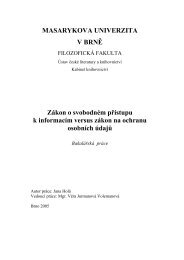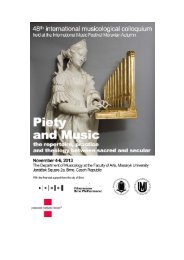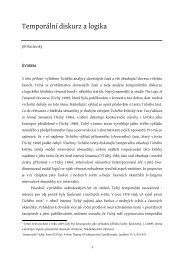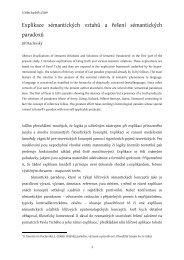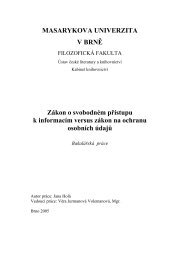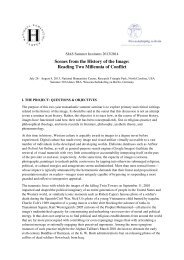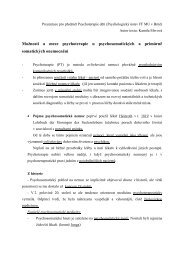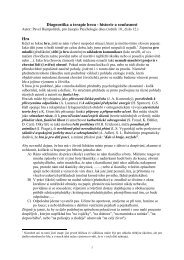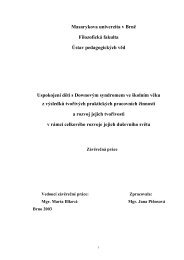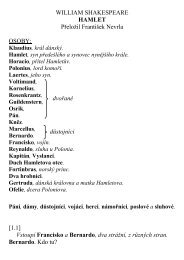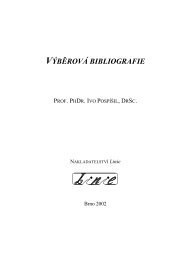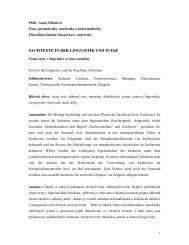The Coda Mirror v2 (but not exactly 2.0) - Masarykova univerzita
The Coda Mirror v2 (but not exactly 2.0) - Masarykova univerzita
The Coda Mirror v2 (but not exactly 2.0) - Masarykova univerzita
Create successful ePaper yourself
Turn your PDF publications into a flip-book with our unique Google optimized e-Paper software.
Tobias Scheer<br />
CNRS 6039, Université de Nice<br />
scheer@unice.fr<br />
GP Round Table<br />
25 April 2009<br />
Budapest<br />
Markéta Ziková<br />
<strong>Masarykova</strong> Univerzita Brno<br />
zikova@phil.muni.cz<br />
this handout and some of the references quoted at<br />
www.unice.fr/dsl/tobias.htm<br />
<strong>The</strong> <strong>Coda</strong> <strong>Mirror</strong> <strong>v2</strong><br />
(<strong>but</strong> <strong>not</strong> <strong>exactly</strong> <strong>2.0</strong>)<br />
(1) purpose<br />
a. to revise the <strong>Coda</strong> <strong>Mirror</strong> (Ségéral & Scheer 2001)<br />
b. under the pressure of arguments coming from the interface<br />
==> shaping linguistic theory according to interface requirements is quite minimalist in<br />
spirit.<br />
1. <strong>The</strong> <strong>Coda</strong> <strong>Mirror</strong> as it stands<br />
(2) the five positions and their clustering<br />
position usual name<br />
a. #__V word-initial<br />
b. VC.__V post-<strong>Coda</strong><br />
c. V__.CV internal <strong>Coda</strong><br />
d. V__# final <strong>Coda</strong><br />
e. V__V intervocalic<br />
strong position<br />
<strong>Coda</strong><br />
weak Positions<br />
(3) consonants in strong position: ungoverned <strong>but</strong> licensed<br />
a. initial consonant #__ b. post-<strong>Coda</strong> consonant C.__<br />
Gvt<br />
Gvt<br />
C V - C V … … V C V C V …<br />
| | | | | |<br />
# C V V R T V<br />
Lic<br />
Lic
- 2 -<br />
(4) consonants in <strong>Coda</strong>s: ungoverned and unlicensed<br />
intervocalic consonants: both governed and licensed<br />
a. internal <strong>Coda</strong> __.C b. final <strong>Coda</strong> __# c. intervoc. V__V<br />
Gvt Gvt Gvt<br />
V C V C V V C V # V C V<br />
| | | | | | | | |<br />
V R T V V C V C V<br />
Lic Lic Lic<br />
(5)<br />
Licensing Government position<br />
segmental health according<br />
to predictions<br />
+<br />
– <strong>Coda</strong> <strong>Mirror</strong> splendid<br />
+ V__V unfavourable<br />
–<br />
– <strong>Coda</strong> unfavourable<br />
+ impossible —<br />
2. Right-edge variation and FEN<br />
(6) two cases<br />
a. the pronunciation of FEN – FEN are subject to a lateral force<br />
b. FEN as the source of lateral relations<br />
(7) empirical correlate: right-edge variation across languages<br />
a. consonant-final words do or do <strong>not</strong> exist<br />
b. extrasyllabicity<br />
1. C#: final consonants do or do <strong>not</strong> behave like codas.<br />
2. VC#: vowels preceding final consonants do or do <strong>not</strong> behave like vowels in<br />
closed syllables.<br />
(8) pronunciation of FEN<br />
a. position in Scheer (2004) and subsequent work on the interface:<br />
FEN are "externally" governed, i.e. by morphology<br />
b. on the assumptions of Direct Interface (Scheer forth), this is impossible because<br />
1. lateral relations ARE the phonological computation, and computation itself<br />
can<strong>not</strong> be modified by external influence. Only its application may be altered.<br />
2. hence lateral relations are <strong>not</strong> representational objects, and therefore can<strong>not</strong> be<br />
inserted.<br />
c. Kaye (1990) was right: the pronunciation of FEN is governed by a parameter. More<br />
on this below.
- 3 -<br />
(9) FEN as a source of lateral relations<br />
a. in GP, FEN have variable lateral abilities.<br />
b. In particular, FEN "can do more" than their internal peers.<br />
E.g. they are able to government-license preceding consonants (e.g. Charette<br />
1991:139ff,1992): English parkø<br />
c. <strong>The</strong>re is a universal implicational relationship between final and internal empty<br />
nuclei: the latter can do at least as much as the former.<br />
Cyran (2003)<br />
(10) the locus of variation<br />
a. extrasyllabicity is a parametric variation:<br />
whether a final consonant is extrasyllabic or <strong>not</strong> does <strong>not</strong> depend on any property of<br />
the morpho-syntactic or the phonological derivation. Rather, the pattern is fixed and<br />
stable across all cases within a given language.<br />
b. occurs only with C-final words:<br />
- there are no extrasyllabic vowels<br />
- there is no parametric variation associated with V-final words<br />
- FEN are thus the locus of variation<br />
==> why?<br />
c. answer below: because FEN are phase-initial<br />
(11) extrasyllabicity is driven by Licensing<br />
this follows from its vocalic effects: long vowels need to be licensed<br />
object concerned<br />
variation<br />
parameter<br />
a. C# 1. C# does <strong>not</strong> behave like a FEN can license: it<br />
(extrasyll) coda<br />
licenses C#<br />
2. C# behaves like a coda FEN can<strong>not</strong> license: C#<br />
remains unlicensed<br />
b. VC# 1. V in VC# behaves like in<br />
an open syllable<br />
FEN can license: it<br />
licenses V in VC#<br />
2. V in VC# behaves like in<br />
a closed syllable<br />
FEN can<strong>not</strong> license: V in<br />
VC# remains unlicensed<br />
3. Overgeneration with independent Gvt and Lic<br />
(12) application of the <strong>Coda</strong> <strong>Mirror</strong> to the parameterized lateral abilities of FEN<br />
in Scheer (2004)<br />
a. default assumption:<br />
Government and Licensing are independent players that combine freely<br />
b. this opens a four-way typology that overgenerates<br />
c. the bad guy is Government: Government is responsible for this overgeneration.
- 4 -<br />
(13) effects of the four-way parametric system of FEN in Scheer (2004:§545)<br />
vowels in final closed word-final consonants are in<br />
FEN can syllables<br />
a. + license<br />
+ govern behave like in open<br />
intervocalic position<br />
b. + license syllables<br />
- govern<br />
post-coda (strong) position<br />
c. - license<br />
+ govern behave like in closed<br />
nightmare position<br />
d. - license syllables<br />
- govern<br />
coda position<br />
(14) the nightmare position<br />
a. has no empirical response: there are no super-weak consonants (which occur only<br />
in word-final position)<br />
b. falls foul of the overall generalisation that consonants and vowels in word-final<br />
closed syllables may be stronger, <strong>but</strong> never weaker than their internal peers<br />
c. this is correctly pointed out by Cyran (2006:539), who argues that phonological<br />
theory should <strong>not</strong> allow for the nightmare situation to exist.<br />
d. other candidate for overgeneration:<br />
Cyran also doubts that (13)b, i.e. where word-final consonants are strong, meets<br />
any empirical echo.<br />
(15) only two of the four situations have an empirical echo<br />
a. we need to get rid of (13)b and (13)c<br />
b. C# are either<br />
1. both governed and licensed<br />
==> intervocalic, that is extrasyllabic<br />
==> preceding vowel in open syllable<br />
2. of neither governed nor licensed<br />
==> true codas, that is non-extrasyllabic<br />
==> preceding vowel in closed syllable<br />
(16) nightmare position also elsewhere:<br />
1. due to licensing duties of the FEN<br />
2. word-internally: VVCV<br />
extrasyllabic languages (i.e. where FEN can license and govern)<br />
e.g. Icelandic<br />
a. C# following a lexically short<br />
vowel: intervocalic position<br />
b. C# following a lexically long<br />
vowel: nightmare position<br />
Lic<br />
Lic<br />
... C V C V C V C V C V<br />
| | | | | |<br />
C V C # C V C #<br />
Gvt<br />
Gvt<br />
variable consonantal strength according to whether the preceding vowel is long or short<br />
hardly meets any empirical echo.
- 5 -<br />
4. <strong>Coda</strong> <strong>Mirror</strong> <strong>v2</strong>: Government and Licensing must <strong>not</strong> be equal-righted<br />
(17) Unitary abilities of FEN can<strong>not</strong> be the only answer<br />
a. solution for the right-edge overgeneration:<br />
lateral abilities of FEN reduce to an on/off setting: either FEN are lateral actors and<br />
can both govern and license, or they are <strong>not</strong>, in which case they can dispense<br />
neither lateral force.<br />
This prevents the system from generating word-final consonants in strong and in<br />
nightmare position.<br />
b. <strong>but</strong> what about word-internal nightmare positions?<br />
c. ==> the right edge is <strong>not</strong> the locus of the problem, it just reveals it.<br />
<strong>The</strong> real problem is in the theory itself, which must <strong>not</strong> be able to generate any<br />
nightmare position at all.<br />
(18) goal<br />
a. to modify the rule of the game so to get rid of the nightmare position while <strong>not</strong><br />
losing any of the generalisations regarding syllable structure and the <strong>Coda</strong> <strong>Mirror</strong>.<br />
Touching any piece of the puzzle impacts the mechanics elsewhere. This is of<br />
course warranted, <strong>but</strong> severely restricts the room for modifications.<br />
b. guide:<br />
Government and Licensing do <strong>not</strong> act independently of one a<strong>not</strong>her; rather, they<br />
obey a natural hierarchy that determines their behaviour when they could in<br />
principle apply simultaneously.<br />
Cyran (2006:534)<br />
(19) Government over Licensing<br />
no constituent can be governed and licensed at the same time. In case a constituent can<br />
potentially be subject to both lateral forces, it will be governed.<br />
4.1. Impact on consonants<br />
(20) direct impact on the identity of intervocalic consonants<br />
a. while they were both governed and licensed before, they are now only governed.<br />
b. critique that has sometimes been voiced in regard of the <strong>Coda</strong> <strong>Mirror</strong> (among others<br />
by Cyran 2006:530ff,537): how could the reaction of an onset be calculated if its<br />
melodic expression is simultaneously inhibited and enhanced?<br />
c. Intuitively, opposite forces cancel each other out.<br />
d. <strong>The</strong> <strong>Coda</strong> <strong>Mirror</strong> has always been explicitly agnostic:<br />
<strong>The</strong> only thing that was important was the ability of the theory to formally<br />
distinguish two weak positions, intervocalic and the coda ("two ways of being<br />
weak", cf. Scheer 2004:§131), while assuring that both of them are weaker than the<br />
Strong Position.<br />
e. the relative strength of both weak positions remained an open question.<br />
Now: intervocalic Cs are governed, i.e. damaged, while coda consonants are <strong>not</strong>.<br />
==> prediction: intervocalic Cs are weaker than coda consonants.
- 6 -<br />
(21) <strong>Coda</strong> <strong>Mirror</strong> <strong>v2</strong><br />
consonants in codas: ungoverned and unlicensed<br />
intervocalic consonants: governed <strong>but</strong> unlicensed<br />
a. internal coda __.C b. final coda __# c. intervoc. V__V<br />
Gvt Gvt Gvt<br />
V C V C V V C V # V C V<br />
| | | | | | | | |<br />
V R T V V C V C V<br />
Lic<br />
Lic<br />
(22) consonants in the <strong>Coda</strong> <strong>Mirror</strong>: ungoverned <strong>but</strong> licensed<br />
a. initial consonant #__ b. post-coda consonant C.__<br />
Gvt<br />
Gvt<br />
C V - C V … … V C V C V …<br />
| | | | | |<br />
# C V V 1 R T V 2<br />
Lic<br />
Lic<br />
(23) <strong>Coda</strong> <strong>Mirror</strong> <strong>v2</strong><br />
position<br />
definition in terms of lateral relations<br />
a. Strong Position {#,C}__ licensed <strong>but</strong> ungoverned<br />
b. coda __{#,C} unlicensed and ungoverned<br />
c. intervocalic V__V governed (<strong>but</strong> unlicensed)<br />
(24) benefits<br />
a. <strong>The</strong> fourth logical possibility, i.e. a constituent that is both governed and licensed,<br />
is ruled out by (19).<br />
b. the configuration "governed <strong>but</strong> unlicensed" characterised the nightmare position<br />
before, <strong>but</strong> now describes regular intervocalic onsets.<br />
==> the system is unable to produce a situation where a consonant is weaker than<br />
both codas and intervocalic onsets.<br />
c. (19) kills two birds with one stone: the equal-rightedness of Government and<br />
Licensing is done away with, and the nightmare position is eliminated.<br />
4.2. Impact on vowels<br />
(25) ground rules:<br />
origin and application of lateral relations<br />
a. nuclei exhaust their lateral potential: nuclei which are enabled to govern do<br />
govern, nuclei which are enabled to license do license (Vol.1:§148).<br />
b. by default, nuclei target their own onset, i.e. "choose" the shortest move.<br />
c. they target other nuclei in two situations:<br />
1. when they are called to either govern or license a preceding empty nucleus.<br />
2. when they govern their onset and hence can<strong>not</strong> license it simultaneously.
- 7 -<br />
(26) nuclei do <strong>not</strong> target their own onset when<br />
a. they are called to govern: ==> strong position<br />
b. they are called to license: ==> long vowels<br />
N.B.: only alternating long vowels (i.e. that may also be short and are left-headed)<br />
need to be licensed. <strong>The</strong>re are also long vowels that are lexically long (i.e. rightheaded)<br />
and insensitive to their righthand context. Both types may also cohabitate<br />
in the same language (e.g. Czech, cf. Ziková 2008).<br />
(27) intervocalic Licensing<br />
a. long vowels b. intervocalic consonants<br />
Gvt<br />
Gvt<br />
C V C V C V C V C V<br />
| | | | | | | |<br />
C V C V C V C V<br />
Lic<br />
Lic<br />
(28) uniformity of intervocalic consonants<br />
unlike in the old system, intervocalic consonants after long and short vowels<br />
experience the same conditions: they are governed (and unlicensed).<br />
(29) definition of open vs. closed syllables<br />
a. vowels in open syllables are licensed.<br />
b. vowels in closed syllables are unlicensed.<br />
(30) vowels in open and closed syllables<br />
a. vowel in an open syllable b. vowel in a closed syllable<br />
Gvt<br />
Gvt<br />
C V C V … V C V C V …<br />
| | | | | | | |<br />
C V C V V 1 R T V 2<br />
Lic<br />
Lic<br />
4.3. Impact on the right edge<br />
(31) recall that FEN can<br />
a. either govern and licence<br />
b. or neither govern nor licence
- 8 -<br />
(32) extrasyllabicity in [+Gvt, +Lic] languages:<br />
uniformity after long and short vowels<br />
a. /VVC#/ are long,<br />
C# after long vowels is in<br />
b. C# after short vowels is in<br />
intervocalic position<br />
intervocalic position<br />
Gvt<br />
Gvt<br />
C V C V C V C V C V<br />
| | | | | |<br />
C V C # C V C #<br />
Lic<br />
Lic<br />
(33) extrasyllabicity in [-Gvt, -Lic] languages<br />
a. /VVC#/ is short, C# is in<br />
coda position<br />
b. C# is in coda position<br />
Gvt<br />
Gvt<br />
C V C V C V C V C V<br />
| | | | | |<br />
C V C # C V C #<br />
Lic<br />
Lic<br />
5. Domain-final is phase-initial<br />
(34) what happens when a phase-defined string arrives in phonology?<br />
On the account of CVCV, two properties of phonological interpretation are hard-wired<br />
a. all strings end in a nucleus<br />
b. strings are parsed from right to left, hence starting with the last nucleus<br />
(35) Regressive interpretation follows from<br />
a. the fact that all lateral relations (and – almost – all phonological processes) are<br />
head-final. That is, phonological computation in CVCV consists of the application<br />
of Government and Licensing to a string that is made of onsets, nuclei and<br />
(eventually) associated melodic material.<br />
b. Given that lateral relations are head-final, the lateral status of constituents (i.e.<br />
whether they are governed and/or licensed, and in turn whether they can govern<br />
and/or license) is always determined by the lateral status of a constituent to their<br />
right.<br />
c. This means, in turn, that the computation of constituent n supposes that the<br />
phonological status constituent n+1 is already determined.<br />
==> phonological computation parses the string from right to left.<br />
d. FEN are thus the last item in the string (from the point of view of Western<br />
spelling), <strong>but</strong> they are the first item to be processed by phonological computation.
- 9 -<br />
(36) why are there are no extrasyllabic vowels?<br />
a. because contentful nuclei come with full lateral specifications.<br />
b. the difference between a an empty and a contentful nucleus is that the latter<br />
inherits full phonological abilities from its melodic content: contentful nuclei are<br />
always good governors and good licensors. Empty nuclei, on the other hand, have<br />
no phonological properties per se: they may be governed, and their governing and<br />
licensing abilities depend on whether they are subjected to Government or <strong>not</strong>.<br />
c. Everywhere else in the linear string <strong>but</strong> for FEN, the lateral properties of<br />
constituents are defined by constituents to their right. In other words, the<br />
phonological computation can<strong>not</strong> begin unless the phonological properties of its<br />
first domino are defined. Since the nucleus itself does <strong>not</strong> bear any, they must be<br />
defined by some other means: a parametric choice.<br />
References<br />
Charette, Monik 1991. Conditions on Phonological Government. Cambridge: Cambridge<br />
University Press.<br />
Charette, Monik 1992. Mongolian and Polish meet Government Licensing. SOAS Working<br />
Papers in Linguistics and Phonetics 2: 275-291.<br />
Cyran, Eugeniusz 2003. Complexity Scales and Licensing Strength in Phonology. Lublin:<br />
KUL.<br />
Cyran, Eugeniusz 2006. Book Review: A Lateral <strong>The</strong>ory of Phonology, by Tobias Scheer.<br />
<strong>The</strong> Linguistic Review 23: 505-542.<br />
Kaye, Jonathan 1990. '<strong>Coda</strong>' licensing. Phonology 7: 301-330.<br />
Scheer, Tobias 2004. A Lateral <strong>The</strong>ory of Phonology. Vol.1: What is CVCV, and why should<br />
it be? Berlin: Mouton de Gruyter.<br />
Scheer, Tobias forth. How morpho-syntax talks to phonology. A survey of extra-phonological<br />
information in phonology since Trubetzkoy's Grenzsignale. Berlin: Mouton de<br />
Gruyter.<br />
Ségéral, Philippe & Tobias Scheer 2001. La <strong>Coda</strong>-Miroir. Bulletin de la Société de<br />
Linguistique de Paris 96: 107-152.<br />
Ziková, Markéta 2008. Alternace e-nula v současné češtině. Autosegmentální analýza. Ph.D<br />
dissertation, <strong>Masarykova</strong> Univerzita v Brně.



